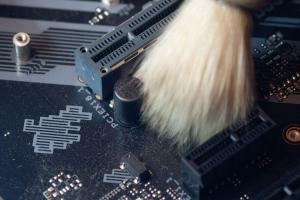Ultimate Guide to Cleaning Your Desktop PC Motherboard: A Step-by-Step Approach

-
Quick Links:
- Introduction
- Why Clean a Motherboard?
- When to Clean Your Motherboard
- Gathering Tools and Materials
- Step-by-Step Cleaning Process
- Preventative Maintenance Tips
- Common Motherboard Issues and Solutions
- Case Studies and Expert Insights
- FAQs
Introduction
Your desktop PC motherboard is the heart of your computer, housing the CPU, RAM, and other vital components that keep your system running smoothly. Over time, dust, debris, and even moisture can accumulate on the motherboard, leading to overheating and potential hardware failure. In this guide, we will explore how to properly clean a desktop PC motherboard, ensuring optimal performance and longevity.
Why Clean a Motherboard?
Cleaning your motherboard is essential for several reasons:
- Improved Performance: Dust buildup can obstruct airflow, leading to overheating.
- Longevity: Regular maintenance can extend the lifespan of your components.
- Preventive Care: Cleaning helps identify and mitigate potential issues before they escalate.
When to Clean Your Motherboard
Knowing when to clean your motherboard is just as important as knowing how. Here are key indicators that it's time for a cleanup:
- Visible dust buildup on the motherboard and components
- Frequent system crashes or overheating
- Unusual noises from the power supply or fans
Gathering Tools and Materials
Before you start cleaning, gather the necessary tools and materials:
- Static-free cleaning cloth
- Compressed air canister
- Soft brush (like a paintbrush)
- Isopropyl alcohol (preferably 99%)
- Cotton swabs
- Screwdriver set
- Antistatic wrist strap (optional but recommended)
Step-by-Step Cleaning Process
Follow these steps to clean your motherboard effectively:
Step 1: Prepare Your Workspace
Choose a clean, dry area free from static electricity. Use an antistatic wrist strap if available.
Step 2: Power Down and Disconnect
Ensure your PC is powered down and unplugged. Disconnect all peripherals and cables.
Step 3: Open the Case
Using a screwdriver, carefully remove the side panel of your desktop case to access the motherboard.
Step 4: Initial Dusting with Compressed Air
Hold the compressed air canister upright and blow away dust from the motherboard. Maintain a distance of about 6 inches to avoid moisture buildup.
Step 5: Clean Components with a Brush
Using a soft brush, gently remove dust from components such as RAM and the CPU cooler. Be careful not to apply too much pressure.
Step 6: Detailed Cleaning with Isopropyl Alcohol
Dampen a cleaning cloth or cotton swab with isopropyl alcohol and carefully clean connectors, sockets, and any stubborn dirt.
Step 7: Final Compressed Air Blast
After cleaning, use the compressed air again to blow out any remaining debris.
Step 8: Reassemble the Case
Once the motherboard is clean and dry, reassemble your case, reconnect all cables, and power on your system.
Preventative Maintenance Tips
To keep your motherboard clean and functioning optimally, consider these tips:
- Regularly monitor system temperatures with software tools.
- Keep your workspace dust-free and avoid smoking around the computer.
- Invest in dust filters for your case fans.
Common Motherboard Issues and Solutions
Understanding common issues can help you maintain your motherboard:
- Overheating: Ensure proper airflow and clean dust regularly.
- Boot Failures: Check for loose connections or faulty components.
- Electrical Short Circuits: Inspect for liquid spills or damaged components.
Case Studies and Expert Insights
Experts recommend cleaning your motherboard at least once every six months, especially for systems in dustier environments. A case study by PC World showed that regular maintenance can boost system performance by up to 20%.
FAQs
1. How often should I clean my motherboard?
It's recommended to clean your motherboard every 6-12 months, depending on your environment.
2. Can I use water to clean my motherboard?
No, never use water. Use isopropyl alcohol or compressed air instead.
3. Is it safe to use compressed air on my motherboard?
Yes, as long as you hold the can upright and avoid moisture buildup.
4. What should I avoid when cleaning my motherboard?
Avoid using harsh chemicals, water, and excessive force. Keep static electricity in mind.
5. Can cleaning my motherboard fix performance issues?
Yes, cleaning can resolve overheating and dust-related issues, improving performance.
6. Do I need special tools to clean my motherboard?
No, basic tools like a soft brush, compressed air, and isopropyl alcohol will suffice.
7. Should I remove components to clean the motherboard?
It's not necessary but can provide better access for thorough cleaning.
8. How can I prevent dust buildup on my motherboard?
Use dust filters, keep your workspace clean, and avoid smoking around your computer.
9. Can I clean my motherboard while it’s still in the case?
Yes, but it’s easier to clean thoroughly if you remove it from the case.
10. What signs indicate my motherboard needs cleaning?
Visible dust accumulation, overheating, and system crashes are common indicators.
Random Reads
- Mastering league of legends windowed mode
- How to find youtube video without knowing name
- How to install tyvek
- How to install virtualbox
- How to play clash of clans on pc
- How to place an ad on gumtree
- How to change android screen timeout
- Check php version
- Check your iphone iccid
- Check printer ink levels windows